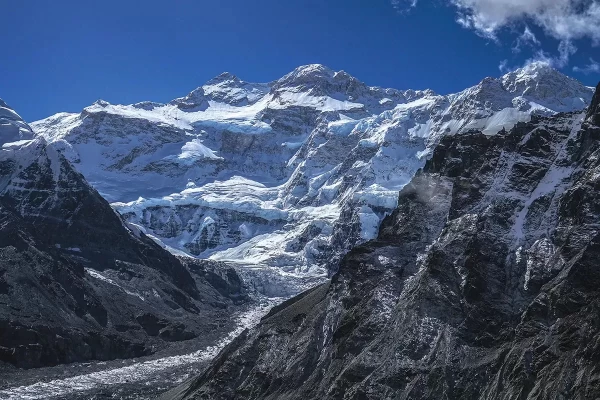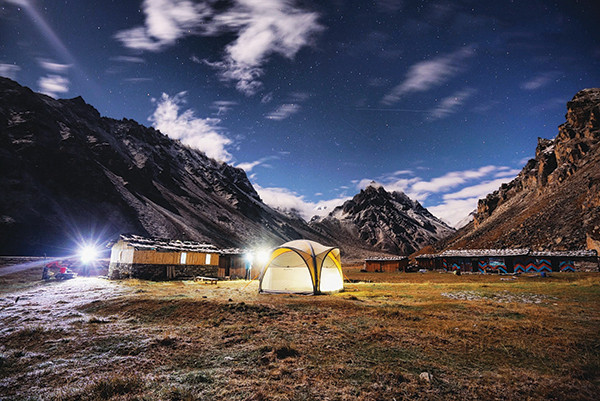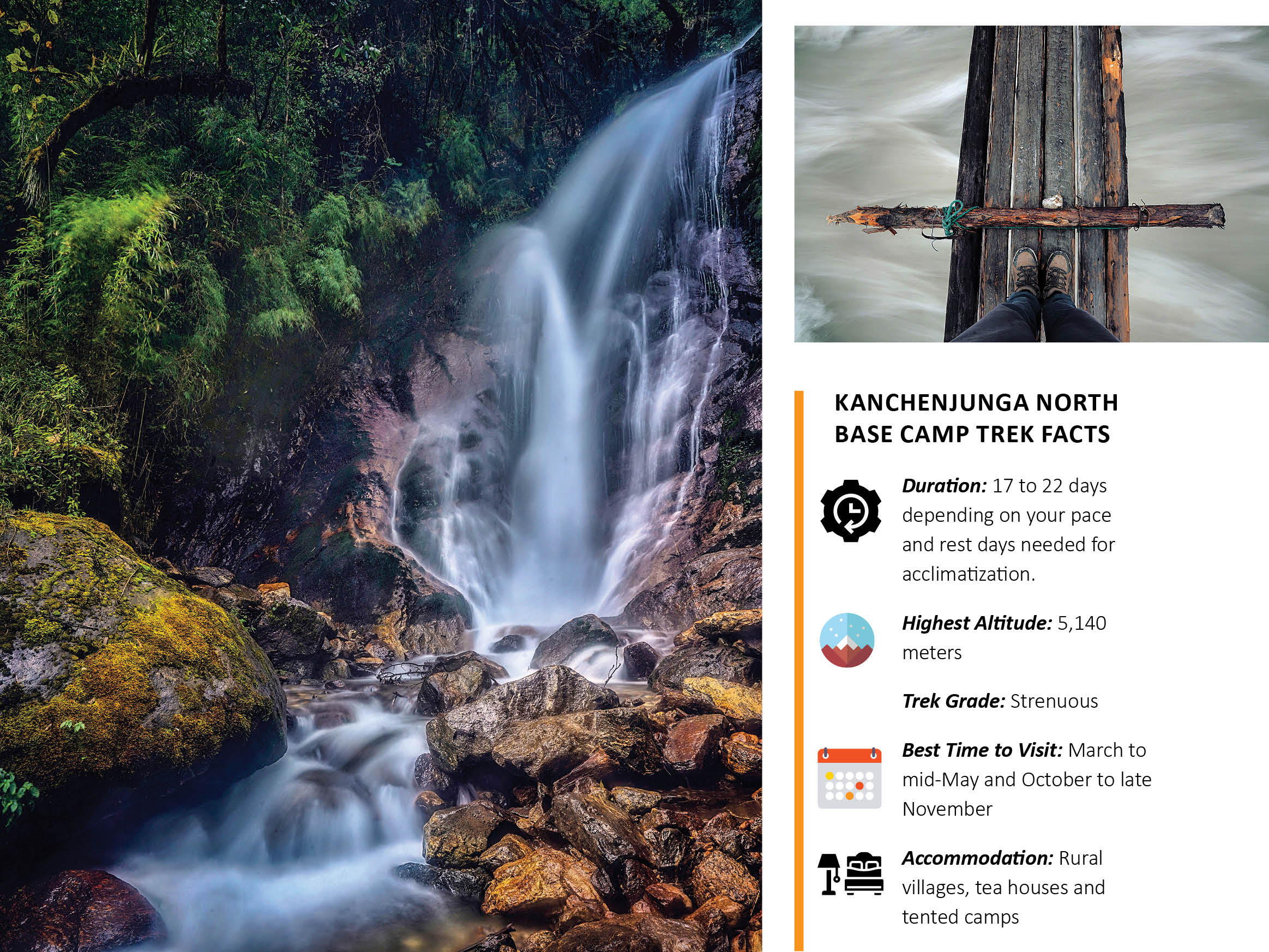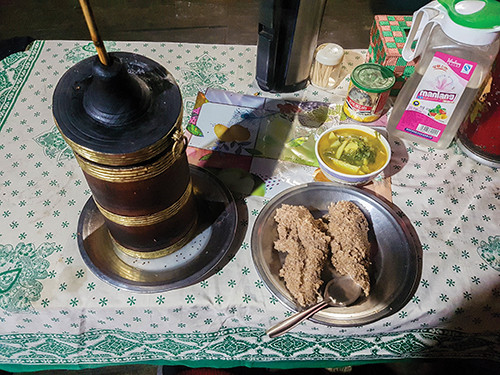Trek To Kanchenjunga

Kanchenjunga is the world’s third-highest mountain. It is located in the eastern region of Nepal. The Kanchenjunga trek is one of the most strenuous treks - but this also makes it rewarding because of the wilderness and unspoiled nature you’ll see.
While trekking, you come across highland forest, rhododendrons in bloom and majestic waterfalls, while getting an authentic experience of the village life in eastern Nepal. Mohan Duwal, an avid trekker, and photographer shares his experiences of the Kanchenjunga trek to the north camp of Pangpema.

Trek to Kanchenjunga: Five Treasures of the Great Snow
In Tibetan, Kanchenjunga means, “Five Treasures of the Great Snow.” It is one of the five peaks of the Kanchenjunga range. The trek has two routes; the trek can be carried out to the north base camp or south base camp, or you can trek to both the north and south base camp on a Kanchenjunga circuit trek. The trek will take about 17 to 22 days depending on your pace and time needed for acclimatization. The highest altitude you’ll reach in this trek is above 5,000 meters.
The trek requires you to walk at least 5 hours each day to reach the next stop. Therefore, you have to plan your trek by calculating the time and determine where to rest for the night. You do not want to keep trekking until nightfall. Since teahouses are not abundant in this trek, you need to carry enough water and food while trekking.
My Kanchenjunga trek started with a one hour flight from Kathmandu to Bhadrapur. There are daily flights that depart to Bhadrapur. After landing, take a nine-hour drive to Taplejung. Depending on the time of your flight, you can rest for the night at either Bhadrapur or Taplejung.

The trek begins from Taplejung to Chirruwa. The first part of the trail was a descent from 1820 m to 1270 m. It took about seven hours to reach the first destination on the trek. After a night’s rest, head out to Sekathum the next morning. The trail will take around five hours to reach Tamur River. You have the option to take a vehicle from Taplejung to Sekathum and start the trek to Amjilosha. If you choose to trek, it takes about seven to eight hours to trek from an altitude of 2000 meters to 2500 meters. After Amjilosha, the next stop is at Gyabla village (2730 m), which takes four hours to trek. However, I chose to go to Phaley, which is an old Tibetan village that has been thriving for more than 150 years. It was enriching to experience the local culture and farming lifestyle of the people. You can enjoy organic food and cheese at Phaley with the warm hospitality of the locals.
The next morning, start the trek towards Ghumsa village (3595 m). As the capital region of Kanchenjunga, there are good facilities here compared to the other rest stops. I took a rest at Ghumsa for acclimatization and enjoyed witnessing the daily life of the locals. From here onwards, trekkers are required to sleep in tents. There are a few teahouses available to replenish food or water before going onward to Khambachen. The trek from Ghumsa to Khambachen takes about four hours. There is a drastic rise in altitude from 3600 m in Ghumsa to 4100 m in Khambachen. It’s best to stop at Khambachen for the night and get acclimatized before moving on Lhonak (4785 m).
Lhonak is the final stop before reaching Kanchenjunga Base Camp. It’s advisable to wake up before the sun rises and make your way towards Pangpema - Kanchenjunga’s north base camp. The five peaks emerged closer as I neared the base camp. If you’re lucky, you might see the sun rise over the five peaks of the Kanchenjunga range. It is wise to reach the base camp early as the peaks will get shrouded in clouds. Pangpema sits at an altitude of 5140 meters and is the highest altitude on the Kanchenjunga trek.

Due to the great effort required to trek Kanchenjunga, trekkers rarely go there. This means that that you can an unadulterated wildlife experience, and you might even spot the elusive Himalayan Blue Sheep.
After spending a day at the base camp, descent down to Ghumsa or trek to Sele La to head towards the south base camp. If you plan to trek to the south base camp, there are rest stops at Cheram, Ramche, and Oktang before reaching Yalung Ri - the south base camp. The descent from the south base camp is the same trail to Ghumsa and descent from there. There is another trail from the south base camp that goes through Tortung to Yamphuding. After which, you trek to Mamanke then Kesuwa before you reach Lalikharka - the final stop before heading to Taplejung.
